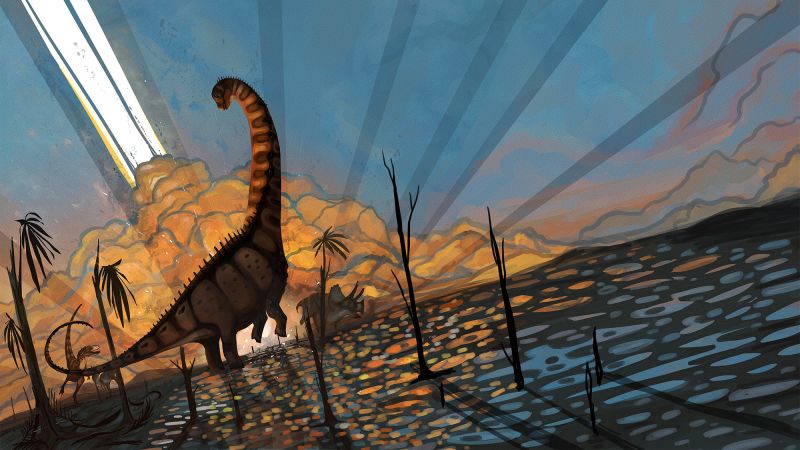
A site in the San Juan Basin of northwestern New Mexico is providing a rare and detailed glimpse into the last days of the dinosaurs. Fossils and rocks at the Naashoibito Member site reveal a vibrant ecosystem filled with a diverse population of dinosaurs just before their sudden disappearance from Earth.
Paleontologists have long debated whether dinosaurs went extinct abruptly when a 6.2-mile-wide (10-kilometer-wide) asteroid struck Mexico’s Yucatán Peninsula 66 million years ago, or if they were already in decline due to weakened ecosystems. The findings from the Naashoibito Member site offer new insights into this ongoing debate.
Unraveling the Timeline
Determining whether the dinosaurs were in decline requires accurately dating fossils and the surrounding rock layers. However, finding fossils in areas precisely dated to just before the extinction event is a rarity. The Hell Creek and Fort Union Formations, spanning Montana, Wyoming, and the Dakotas, have been key sites for such studies. These formations have preserved evidence of species like Triceratops and Edmontosaurus, but lacked long-necked dinosaurs, leading some scientists to theorize their earlier extinction.
New research has now dated rocks in the Naashoibito Member to the same period as the Hell Creek Formation, shedding light on the types of dinosaurs that inhabited different parts of North America shortly before their extinction. Among the dinosaurs identified was Alamosaurus, one of the largest long-necked dinosaurs ever, according to a study published in the journal Science.
“What our new research shows is that dinosaurs are not on their way out going into the mass extinction,” said Andrew Flynn, lead study author and assistant professor in the department of geological sciences at New Mexico State University. “They’re doing great, they’re thriving, and the asteroid impact seems to knock them out.”
Cracking the Rock Time Code
Dinosaur fossils were first discovered in the San Juan Basin in the mid- to late 1800s, but dating the rock layers containing these fossils is complex. The layers must be exposed for study, and then accurately dated. Flynn noted that these challenges make dinosaur-bearing rocks from the last 400,000 years of the Cretaceous quite rare.
According to Dr. Lindsay Zanno, head of paleontology at the North Carolina Museum of Natural Sciences, the fossil record is incomplete. “Species might have failed to enter the fossil record, they might have been preserved as fossils but not yet discovered, or they might have been discovered but lack essential context,” Zanno wrote in an article accompanying the research.
Efforts to establish a detailed timeline at the Naashoibito Member site began in 2011. The team measured rock layers, collected samples, and identified fossil locations. One method used to date the rocks was comparing samples with Earth’s magnetic field reversals, which are well-documented over time. This allowed researchers to narrow down the timeline significantly.
“The end-Cretaceous mass extinction, fortunately for us, took place during a relatively short period of reversed polarity, which makes it much easier to say what our data correlates to,” Flynn explained.
Regions of Diverse Dinosaurs
The study highlights two distinct dinosaur communities in North America, divided between north and south regions. Both areas had common dinosaurs like Tyrannosaurus rex and Torosaurus, but the presence of duck-billed dinosaurs varied. The north lacked giant, long-necked sauropods, which led some paleontologists to believe they had already vanished.
In contrast, the south, including the Naashoibito Member, was home to Alamosaurus, which thrived in the region. “The fact that one of the biggest dinosaurs witnessed an asteroid striking the planet truly illustrates how dinosaurs were thriving to the very end,” said study coauthor Steve Brusatte, a professor of paleontology and evolution at the University of Edinburgh.
“I can imagine the scene, one minute a jet plane-sized dinosaur was shaking the ground as it walked, the next minute the whole Earth was shaking with the energy unleashed by the asteroid,” Brusatte said.
Climate conditions likely contributed to the differing dinosaur communities. The Naashoibito Member resembled a warm, humid tropical forest, while the Hell Creek area had cooler, coastal plain conditions. “They were doing what dinosaurs had been doing for over 150 million years, adapting to their local conditions,” Brusatte noted.
Implications and Future Research
The findings from New Mexico challenge previous notions of a gradual decline in dinosaur populations. Michael Benton, professor of vertebrate paleontology at the University of Bristol, acknowledged the significance of the study but cautioned that it represents just one location. “In general, dinosaurs of the last 6 million years of the Cretaceous were less diverse,” Benton wrote, suggesting an overall decline with pockets of rich diversity.
Darla Zelenitsky, associate professor at the University of Calgary, believes the findings could reshape our understanding of dinosaurs before the mass extinction event. Her team’s work in Alberta aligns with the idea of stable dinosaur populations. “The research team uncovered compelling new evidence (…) that dinosaurs were still going strong ‘til the very end,” Zelenitsky stated.
While the study focuses on dinosaurs, it also serves as a reminder of the vulnerability of species to sudden environmental changes. “Sudden climate and environmental change can catch animals and ecosystems unaware,” Brusatte said, “and can defeat even the strongest and most iconic of species.”







